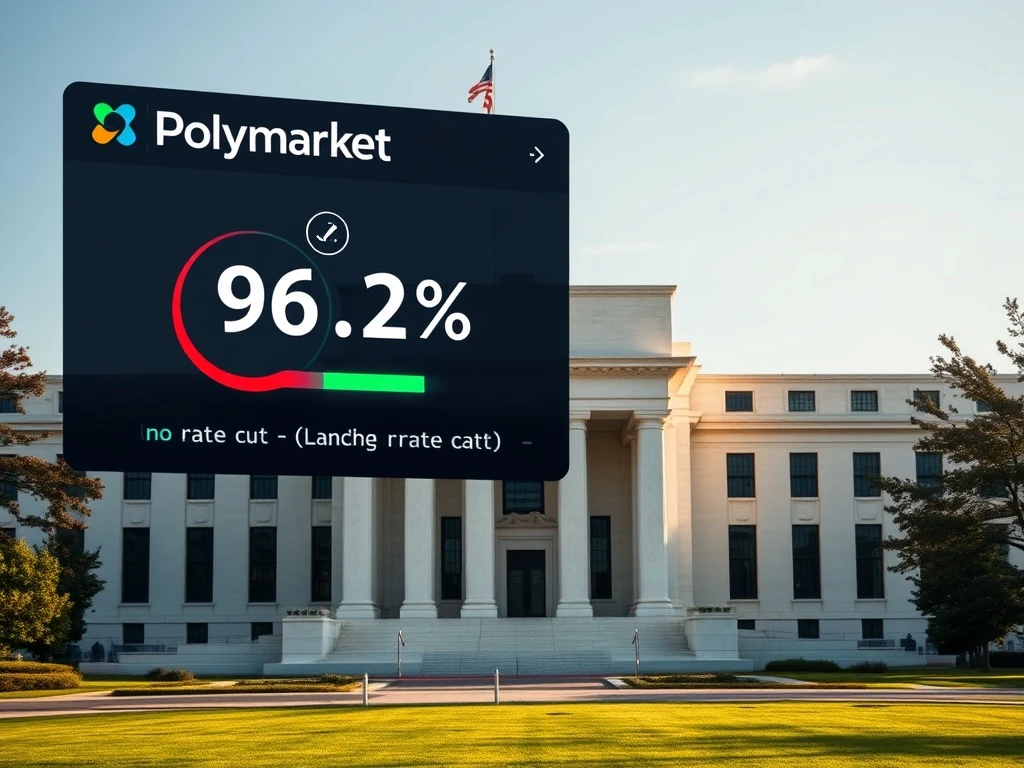Polymarket Reveals Stunning 96.3% Odds Fed Will Hold Interest Rates Firm Despite Trump’s Push

Imagine having a crystal ball for the economy, one that aggregates the collective wisdom (and wagers) of thousands. That’s precisely what Polygon-based prediction market Polymarket offers, and its latest forecast for the U.S. Federal Reserve’s upcoming policy meeting is sending clear signals across financial markets, including crypto.
Polymarket’s Unwavering Forecast: No Rate Cuts Ahead?
Bettors on the innovative Polymarket platform have spoken, pricing in a remarkable 96.3% probability that the U.S. Federal Reserve will maintain interest rates unchanged during its July 29–30 policy meeting. This near-unanimous expectation among market participants suggests a strong belief that the Fed will continue its data-dependent approach, delaying any significant rate cuts until there is clearer evidence of inflationary moderation.
The odds are derived from real-time trading on Polymarket’s contracts, offering a dynamic snapshot of collective sentiment. While the overwhelming majority points to no change, a small percentage (3%) of bets are allocated to a 25-basis-point rate cut, with less than 1% for larger cuts or hikes. This breakdown highlights a consensus rarely seen in volatile financial markets.
Here’s a quick look at the current Polymarket odds for the upcoming Fed meeting:
| Outcome | Polymarket Odds |
|---|---|
| Fed Holds Rates Unchanged | 96.3% |
| 25 Basis Point Rate Cut | 3.0% |
| Larger Cuts or Hikes | <1.0% |
Decoding the Fed Interest Rates: Why Stability Reigns
The market’s conviction aligns with recent statements from Fed Chair Jerome Powell, who has consistently emphasized the need to assess the economic impact of various factors, including tariffs and other inflationary pressures, before adjusting Fed interest rates. This cautious stance underscores the central bank’s commitment to price stability and full employment, rather than succumbing to external pressures.
Despite this, former President Donald Trump has publicly criticized the Fed’s measured approach. During a July 24 visit to the Fed’s renovation site, Trump asserted that the central bank should have already begun easing rates. This disparity between political rhetoric and market expectations underscores the limited influence of high-profile advocacy on the Fed’s independent policy decisions.
The Power of Prediction Markets: A New Barometer for Monetary Policy
Prediction markets like Polymarket have increasingly gained traction as reliable barometers of market sentiment. They aggregate diverse perspectives, often forecasting outcomes more quickly and accurately than traditional expert models. This agility allows them to capture subtle shifts in expectations, providing valuable insights into complex economic events.
For those interested in monetary policy, these platforms offer a unique, real-time window into how the market perceives the future. The 96.3% probability of no rate cut suggests that traders are highly confident in the Fed’s current trajectory, which includes a three-month pause in rate adjustments and a laser focus on stabilizing inflation expectations.
Beyond the Headlines: Navigating Political Rhetoric and Fed Independence
The Federal Reserve’s independence in setting interest rates remains a critical pillar of its credibility. The central bank’s framework prioritizes key economic metrics such as employment, inflation, and industrial output, rather than external pressures from elected officials. This autonomy has historically bolstered the Fed’s standing on the global stage.
However, the recent public tension between figures like Donald Trump and Jerome Powell has raised broader questions about the delicate balance of power in monetary policymaking. While political commentary can draw attention, the market’s reliance on data-driven decisions by an independent Fed is evident in Polymarket’s strong odds.
What’s Next for Polymarket and the Economy?
The July meeting will undoubtedly be a focal point for global markets, but Polymarket’s odds indicate little movement in the short term regarding rate cuts. This stability in immediate expectations allows businesses and consumers to plan with greater certainty, even as broader economic forces continue to evolve.
Longer-term probabilities, however, show a gradual rise in the likelihood of Fed Chair Jerome Powell’s exit from his role. Contracts are trading at 1% for his departure by July 31, 5% by August 31, and 17% by year-end 2025. These figures suggest that while immediate leadership changes are unlikely, medium-term speculation has increased amid ongoing political tensions and the challenging economic landscape.
In conclusion, Polymarket’s overwhelming odds signal a robust market consensus: the Federal Reserve will hold its ground on interest rates. This reflects confidence in the Fed’s independent, data-driven approach to monetary policy, despite high-profile political advocacy for immediate changes. Prediction markets continue to prove their value as powerful tools for gauging collective sentiment, offering a compelling glimpse into the future of our economy.
Frequently Asked Questions (FAQs)
1. What is Polymarket and how does it work?
Polymarket is a decentralized prediction market built on the Polygon blockchain. Users can bet on the outcomes of future events, from political elections to economic indicators like Fed interest rates. The platform aggregates these bets into probabilities, offering real-time insights into collective market sentiment.
2. Why is the Fed likely to hold interest rates unchanged?
The Federal Reserve maintains a data-dependent approach to monetary policy. They are likely to hold interest rates unchanged due to a need for clearer, sustained evidence of inflationary moderation and to assess the full economic impact of current policies and global factors like tariffs, prioritizing stability over premature adjustments.
3. How do prediction markets influence financial analysis?
Prediction markets offer a unique and often more agile form of financial analysis compared to traditional forecasts. By aggregating diverse perspectives and real-money bets, they can quickly capture shifts in market expectations, providing a valuable barometer for future outcomes and supplementing expert models.
4. What is the significance of the Federal Reserve’s independence?
The Federal Reserve’s independence allows it to make monetary policy decisions based on economic data and its dual mandate (maximum employment and price stability) rather than political pressure. This autonomy is crucial for maintaining the Fed’s credibility, ensuring long-term economic stability, and preventing policies that could lead to inflation or recession due to short-term political considerations.
5. Are there any long-term predictions from Polymarket beyond rate cuts?
Yes, Polymarket also features contracts on longer-term probabilities. For instance, the platform currently shows increasing odds for Fed Chair Jerome Powell’s departure from his role, with probabilities rising from 1% by July 31 to 17% by year-end 2025, reflecting growing speculation amid ongoing political and economic tensions.








